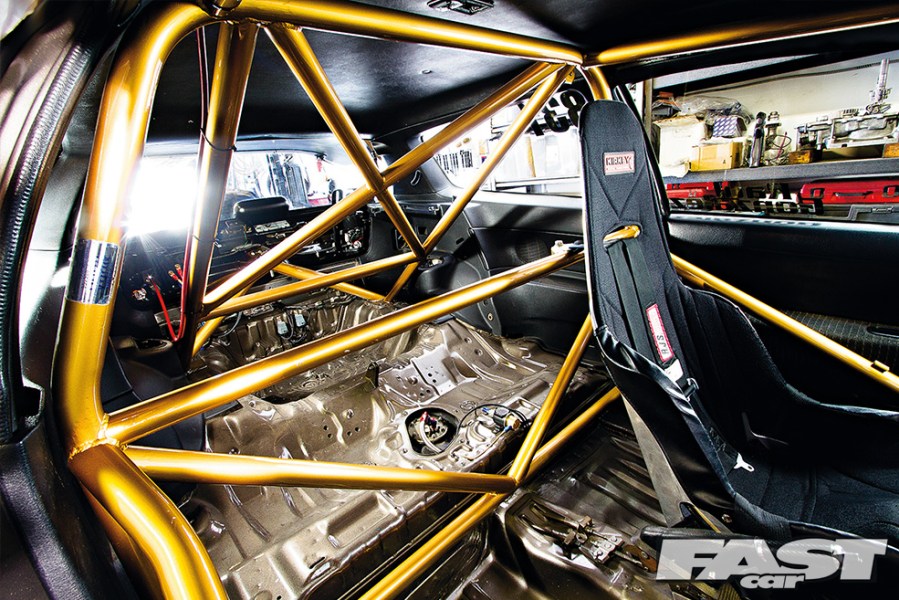Strengthening your car’s body to provide a stiffer, safer platform for big-power tuning is a must. Find out more with our handy roll cage guide.
Words by Rich White.
Taking a look across the entire spectrum of the tuning scene, most of us want to go faster. Increasing engine performance is the number-one area of interest for a large proportion of petrolheads, and that’s partly because it’s so accessible. Bolting on that larger turbo, adding that fancy fuel system or larger front-mount intercooler… it’s all relatively easy to achieve and the gains are clear to see.
However, you should always spare a thought for the rest of the car that has to accommodate that boost in power. Safety is paramount, and if you consider how much faster you’ll be going, and how much extra stress you’ll be putting through the rest of the car, then beefing up the strength of your chassis should come high on your list of priorities. Read on for exactly what you need to consider.
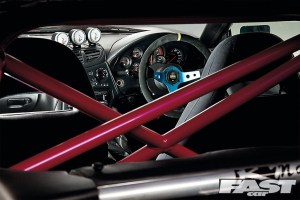
Roll Cage Guide:
Take a look at any form of tin-top competition car, and you’ll notice they all have comprehensive roll cages. WRC, BTCC and GT – all of these represent the pinnacle of closed-wheel racing cars, where speeds are massive and driver safety is vital. The vast majority of labour needed to prepare a car for top-level motorsport concerns body preparation, as opposed to the engine work. Teams spend somewhere in the region of 700 man-hours preparing a WRC shell, for example.
Roll cages not only create a safe environment for the people inside, but crucially, they also drastically reduce the amount that the bodyshell flexes. You think that your car’s bodyshell is a metal structure that’s not going to twist, right? Well, just try jacking your car up at one corner and check if the doors still shut properly – often, particularly with older cars, you can see a visible difference in the panel gaps, but it’s commonplace on new cars, too. This also happens when you’re pushing the limits of performance: each time you accelerate, brake or corner hard, there’s unwanted movement that creates a sloppy, unsure feeling for the driver. Adding a roll cage is a step in the right direction for reducing this. There are two main types of cage, which we will now investigate further.
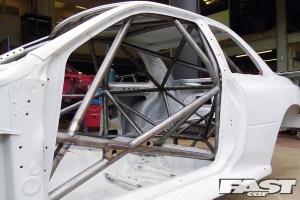
Welded-In Roll Cages
This is where it’s really at. Used in professional motorsport, weld-in cages offer the ultimate in terms of occupant protection and bodyshell rigidity, and are designed to triangulate and mechanically link the major body and suspension pick-up points. The downside is that it’s an involved and complex job to fit a weld-in cage, and you’ll need a professional to do it for you.
If you have any desire to compete in motorsport, then it’s critical to check what rules and regulations your cage needs to adhere to in order for the car to be eligible to race. This could vary from the physical cage design down to the thickness of the tubing used. It’s not worth risking it, only to turn up to your first event and have the scrutineer decline your car and send you on your way. Likewise, a certificate for the roll cage is a must-have, so make sure if you’re fitting a cage that a certificate is supplied at the time of purchase, too.
Materials Used
Covering raw materials first, there are two main types of steel that fabricators use for weld-in cages. CDS (Cold Drawn Steel) is the cheapest option, which represents good value for money, but the downside is that more material is required to meet the necessary strength levels. As a result, cages constructed with CDS are quite heavy. Most bolt-in cages are CDS, but if you’re going to the trouble of having a weld-in cage installed, then it’s worth spending extra to commission a T45 structure instead. These cages use a carbon-manganese seamless tube that meets aerospace regulations and is considerably lighter than CDS – anywhere between 10-30kg depending on the cage design. It’s about 20 percent more expensive, but the weight saving should outweigh the extra cost at this level.
Fitting The Cage
Fitting weld-in cages involves a strict procedure for proper installation. This includes assembling the cage piece by piece inside the car. Usually you would lightly tack it together without fully welding it first. Then, you cut small holes in the floor of the car, and you lower the feet of the cage through the floor. This allows for 360-degree welding around the upper tube joins.
A proper weld-in cage will have additional tubes that fit through the bulkhead, welded to the front suspension turret tops. Again, you would typically mock these up in place, then remove them again to be fully welded away from the car, before reinstalling them. Fitting a weld-in cage is a complex procedure and it’s really advisable to approach a company that specializes in manufacturing and fitting roll cages, as they’ll be able to offer a turn-key solution and take the headache out of the equation.
Whereas a bolt-in cage will commonly attach to the car at six main places, a good weld-in cage should weld to the shell at multiple points, which minimizes unwanted flexing. The downside of a weld-in cage is that the car will require a trip to the paint shop afterwards, and in order to fit the cage in the first place, it’s common to strip the shell of virtually all components. It’s certainly not a job you can do in a weekend, but if you’re looking for the ultimate in occupant protection and body strengthening, then this is the answer.
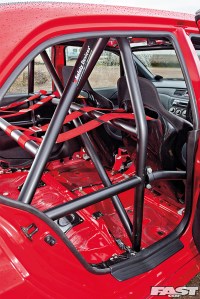
Bolt-In Roll Cages
As the name suggests, a bolt-in roll cage is quite simply a cage that bolts directly to your car’s bodyshell. If you’re looking for a quick and easy solution to add strength to your car without taking the whole thing apart, then a bolt-in cage is a good option. You can fit them easily and they often don’t require anything in the way of fabrication to the shell beforehand – a few simple drilled holes can be all that’s needed. Also, the tubes are commonly powder coated, so you can fit them without needing any additional paintwork. And lastly, if you decide at a later date you want to remove the entire cage, then this is easily achievable, too.
Six-Point Cages
The most common type of bolt-in cage is a six-point, which attaches to the shell at the base of the A-pillars, B-pillars and the rear suspension turrets. This provides a general area of protection for the occupants in the event of a crash. Look for a cage with a rear diagonal tube, or even better, a rear cross – this will be a much better option than some of the real bare-bones offerings out there. Spare a thought for harness mountings at this point, too. If you plan to fit bucket seats and harnesses, then often the best place to attach the harnesses at the rear is around the cage, and special harness tubes are usually an option at the time of ordering.
Types of Construction
You should avoid the dreaded ‘dash-dodger’ cages wherever possible. This is a cage where the A-pillar tubes have bends in them to fit around the dashboard. In the event of a roll, side or frontal impact, this type of cage has a nasty habit of creasing just where these bends are situated. Instead, look for a cage with straight tubes from the bottom of the windscreen to the floor – it’ll often require a little trimming of the dashboard to fit, but the benefit is that it’ll do its job properly in the event of a crash. In terms of base plates, or foot plates, it’s highly advisable to spread the load where the cage bolts to the car.
You can achieve this by sandwiching the floor with steel plating, and bolting the cage through the entire lot. This means that, should the worst happen and you roll the car, the legs of the cage don’t simply punch through the floor. If the car’s old, then don’t rule out rust, either – make sure you check the integrity of the floorpan before going further. The best type of bolt-in cages come supplied with foot plates, which require welding to the floorpan. This is more involving to fit, but the benefit is that the cage will have a proper base to mount to. A little common sense goes a long way – the goal is to make sure the cage has a large area to transmit force into the car should the worst happen.
Door Bars
Some bolt-in cages come with door bars, others don’t – just bear in mind that side-impact crashes have a higher injury rate than most other types of crash. The area of deformation of the side of the car is so small that it’s critical to maximise strength in this area. A door bar cross is the best solution, although it does mean getting in and out of the car is more difficult, so you should perhaps reserve it for more serious trackday cars. But door bars have proven to save lives, so they’re worth a thought if you’re in the market for a cage.
Half Cages
If you’re looking to go the other way and are really looking for a minimal solution, then you should consider a rear-only or ‘half’ cage. This is ideal in occasional-use track cars where you don’t want to sacrifice usability. This type of cage does away with the front half of the cage and instead bolts at the base of the B-pillars, so it’s still effective in a roll. However, it won’t do much in the event of a side or front impact and is definitely not acceptable for most forms of motorsport.
Lastly, try to stick to a reputable brand when buying a bolt-in cage. Too often, we come across shoddy cages that would probably do more harm than good in the event of a crash. Also check the tube joints – if there are small brackets joining the tubes held together by thin bolts, then it’s probably advisable to shop elsewhere. The key point to remember is that a bolt-in cage is only ever as strong as the joints holding the tubes together. Likewise, alloy roll cages are a thing of the past, and are now banned in motorsport, mostly due to metal fatigue. Some bolt-in alloy ‘show’ cages are available, but this type of product is about looks, not safety or stiffness. Buy a decent steel cage from a respected manufacturer, and we promise that you won’t look back.
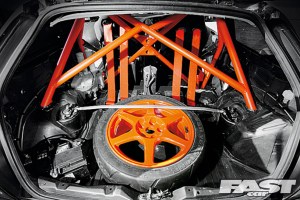
Roll Cage Tips
Having a roll cage in a track car is one thing, but bear in mind that they’re not always a good idea in a road car. Consider them as something else for the occupants to come into contact with during a crash. We generally advise that you only use a roll cage in combination with a fixed-back bucket seat and a proper harness. Be sure to fit some high-density foam on any tubing around the occupants’ heads, and make sure it’s not cheap roll-cage padding – look for some FIA-approved foam from a reputable company such as OMP.
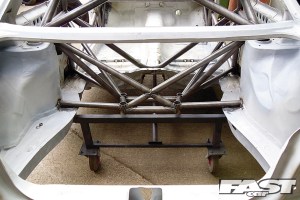
Seam Welding
Like a weld-in cage, seam welding is a job confined to high-end motorsport, or those who build track cars from the ground up. From the factory, most manufacturers spot-weld their cars together. This is fine, but spot welds can break and degrade over time and if you’re looking to reduce flexing in your car’s bodyshell, then seam welding is another option. Typically done with either a Tig or a Mig welder, you apply seam welds along joins or ‘seams’ where panels meet. Most seam welds are commonly around 30-40mm in length, with a similar distance between separate welds.
Seam welding requires a lot of preparation: you’ll need to strip the shell of any paint or seam sealer in the areas you are looking to weld. If you’re going to the lengths of fitting a weld-in cage, then it’s common procedure to have this done at the same time. Some motorsport teams avoid seam welding, as there is a counter-argument that in the event of a crash, a fully seam-sealed shell is a nightmare to repair and replacing panels becomes much harder. But the benefits are clear to see and it’s still a very commonly used technique in the world of race and rally car preparation.
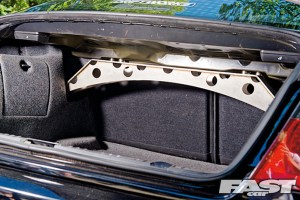
Bracing
Okay, so if you don’t want to go the whole hog and fit a roll cage, it’s understandable. They’re not for everyone, and certainly if it’s predominantly a daily-driven road car then there are arguments for and against fitting a cage. However, you can still do away with some of that unwanted bodyshell flex by fitting an array of strut and chassis braces, which are widely available on the market.
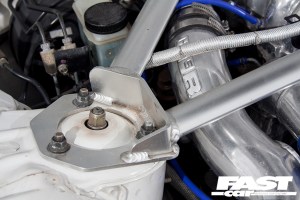
Strut Braces
Strut braces have a straightforward purpose in life, and that’s to eliminate unwanted flexing between the top mounts on your car’s suspension. Without additional bracing, it’s common to have some ‘wandering’ between your top mounts during hard cornering, which can give a wallowy feel. For ensuring razorsharp turn-in and predictable handling, a strut brace is an easy and cheap fix. They’re often available for both the front and rear of your car depending on the make and model.
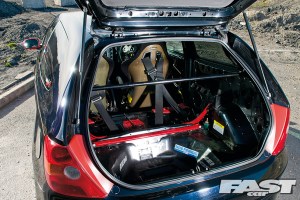
Chassis Braces
Adding some chassis bracing helps keep the body panels aligned, and helps the suspension components move freely as they’re supposed to. They typically connect major suspension components or subframes directly to the car’s body to reduce unwanted twisting, and are a step in the right direction towards stiffening your car’s bodyshell without resorting to a roll cage. They come in various shapes and sizes, and are usually available for the front, rear and sides of the underneath of the car, as well as strengthening the area where the A-pillar and inner wing interface.

